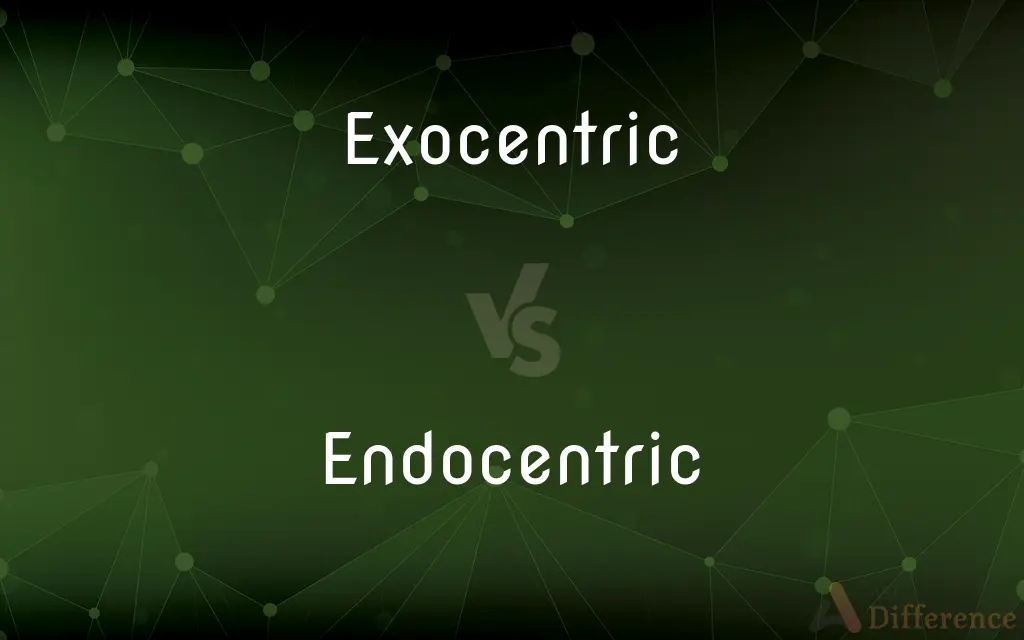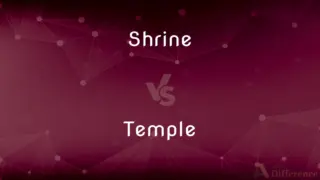Exocentric vs. Endocentric — What's the Difference?
Edited by Tayyaba Rehman — By Fiza Rafique — Updated on March 19, 2024
Exocentric compounds have a head that is not explicitly present, while endocentric compounds have a clear, identifiable head that determines their category.

Difference Between Exocentric and Endocentric
Table of Contents
ADVERTISEMENT
Key Differences
Exocentric compounds, also known as "headless" compounds, are linguistic formations where the compound as a whole does not belong to the same category as any of its parts. For example, in the term "pickpocket," the entire concept does not describe a type of pocket or picking action, but rather a person who picks pockets. Conversely, endocentric compounds have a clear head, which is one of the elements of the compound that determines its lexical category. For example, "blackboard" is clearly a type of board, making "board" the head of the compound.
In terms of function, exocentric compounds often create new meanings or concepts that are not directly inferable from the meanings of their components. This can lead to creative and idiomatic expressions in a language. Endocentric compounds, on the other hand, tend to be more transparent, with the compound's meaning being a specific instance or type of the head's meaning, as seen in "red wine," where "wine" is the head that classifies the type of beverage.
Exocentric compounds can sometimes be more challenging to understand for non-native speakers or learners of a language due to their idiomatic nature. The meaning of the compound must often be learned as a whole rather than deduced from its parts. In contrast, the meaning of endocentric compounds can usually be more easily guessed by understanding the meanings of the constituent parts and the way they are combined.
In morphology, the study of word formation, exocentric compounds are of particular interest because they illustrate how new lexical items can emerge with properties that are not predictable from their constituent parts. Endocentric compounds, while also interesting, tend to conform more closely to regular patterns of word formation, making them somewhat less puzzling from a morphological standpoint.
The distinction between exocentric and endocentric compounds is not just a matter of linguistic curiosity but has practical implications in fields such as computational linguistics, where understanding the structure and meaning of compounds is important for tasks like machine translation and natural language processing.
ADVERTISEMENT
Comparison Chart
Definition
Compounds where the whole does not belong to the category of any of its parts.
Compounds with a clear head that determines the compound's category.
Example
"Pickpocket" - not a type of pocket or picking.
"Blackboard" - a type of board.
Nature
Often idiomatic and creative.
More transparent and predictable.
Understanding
May require learning the compound as a whole.
Meaning can often be deduced from the parts.
Morphological Interest
Illustrates emergence of new lexical items with unpredictable properties.
Conforms to regular patterns of word formation.
Compare with Definitions
Exocentric
A compound whose meaning does not directly relate to its parts.
Pickpocket refers to a person, not an action or object.
Endocentric
Generally easier for language learners due to their compositional nature.
Sailboat is easily understood as a type of boat.
Exocentric
Often idiomatic and can create unique conceptual categories.
Skinhead describes a person with a shaved head, not the head itself.
Endocentric
Illustrates regular patterns of word formation in language.
Toothbrush is predictably a brush for teeth.
Exocentric
Adds richness and creativity to language through non-literal compound formation.
Butterfingers describes clumsiness, not literal buttery fingers.
Endocentric
A compound with a constituent part that specifies its category.
Red wine is clearly a type of wine.
Exocentric
Can be challenging to interpret without prior knowledge.
Bigmouth refers to a talkative person, not a large mouth.
Endocentric
The meaning is more directly tied to the parts of the compound.
Highchair is a type of chair.
Exocentric
Demonstrates how new meanings are generated in language beyond simple compositionality.
Blue-collar describes a type of worker, not a collar color.
Endocentric
Reflects a straightforward way of creating new terms within existing categories.
Greenhouse is a transparent term for a type of house.
Exocentric
Of or relating to a group of syntactically related words, none of which is functionally equivalent to the function of the whole group. For example, none of the words in the phrase on the table is an adverb, yet they combine to form a phrase having adverbial function.
Endocentric
Of or relating to a group of syntactically related words, at least one of which is functionally equivalent to the function of the whole group. For example, the noun table in the noun phrase the old table is endocentric because it has the same grammatical function as the whole noun phrase.
Exocentric
Of or relating to a compound word whose referent is not the same as the referents of any of its constituent parts. For example, the noun razorback does not refer to a type of back, but to a type of hog (one having a sharply ridged back).
Endocentric
Of or relating to a compound word whose referent is the same as the referent of one of its constituent parts. For example, the noun blackboard is endocentric in that it refers to a type of board.
Exocentric
Focused or centered on something outside of itself.
Endocentric
Focused or centered within itself, and not on something external.
Exocentric
Not having the same part of speech as any of its constituent words.
Endocentric
Fulfilling the same grammatical role as one of its constituents.
The noun "houseboat" is endocentric because "boat" is also a noun.
Exocentric
Not having the same semantic referent as the semantic referent of any of its constituent parts.example=bats in the belfry
scarecrow
scarecrow
Endocentric
(grammar) An endocentric compound.
Exocentric
(grammar) An exocentric compound.
Endocentric
Fulfilling the grammatical role of one of its constituents;
When `three blind mice' serves as a noun it is an endocentric construction
Exocentric
Not fulfilling the same grammatical role of any of its constituents;
When `until last Easter' serves as an adverb it is an exocentric construction
Common Curiosities
Can you give an example of an endocentric compound?
"Snowball" is an endocentric compound where "ball" is the head, indicating it is a type of ball made of snow.
How do endocentric compounds aid in language learning?
Endocentric compounds are more predictable and their meanings can often be deduced from their parts, making them easier for language learners to understand.
Can the meaning of an exocentric compound change over time?
Yes, like all linguistic expressions, the meanings of exocentric compounds can evolve, sometimes becoming more literal or more figurative over time.
How do exocentric compounds challenge computational linguistics?
Their idiomatic nature and the fact that their meanings cannot always be deduced from their parts make exocentric compounds challenging for natural language processing and machine translation.
What is the significance of studying exocentric compounds in linguistics?
Studying exocentric compounds helps linguists understand how language evolves and accommodates new and idiomatic expressions, enriching the language's expressiveness.
Why are exocentric compounds considered idiomatic?
Exocentric compounds often convey meanings that are not directly inferable from their parts, making them akin to idiomatic expressions in their creativity and unique conceptualization.
What is an exocentric compound?
An exocentric compound is a linguistic formation where the compound's overall category does not align with any of its parts, often leading to idiomatic meanings.
Are all compound words either exocentric or endocentric?
Most compound words can be classified as either exocentric or endocentric, but there are some cases where the classification may be more ambiguous or debated among linguists.
Do exocentric compounds exist in all languages?
While not all languages use compounds to the same extent, many languages do have mechanisms for creating compound words, including exocentric types, reflecting a universal aspect of human linguistic creativity.
How do endocentric compounds contribute to vocabulary expansion?
Endocentric compounds allow for the efficient creation of new words within existing categories by combining known elements, thus expanding the vocabulary in a systematic way.
Share Your Discovery

Previous Comparison
Field vs. Plain
Next Comparison
Shrine vs. TempleAuthor Spotlight
Written by
Fiza RafiqueFiza Rafique is a skilled content writer at AskDifference.com, where she meticulously refines and enhances written pieces. Drawing from her vast editorial expertise, Fiza ensures clarity, accuracy, and precision in every article. Passionate about language, she continually seeks to elevate the quality of content for readers worldwide.
Edited by
Tayyaba RehmanTayyaba Rehman is a distinguished writer, currently serving as a primary contributor to askdifference.com. As a researcher in semantics and etymology, Tayyaba's passion for the complexity of languages and their distinctions has found a perfect home on the platform. Tayyaba delves into the intricacies of language, distinguishing between commonly confused words and phrases, thereby providing clarity for readers worldwide.














































